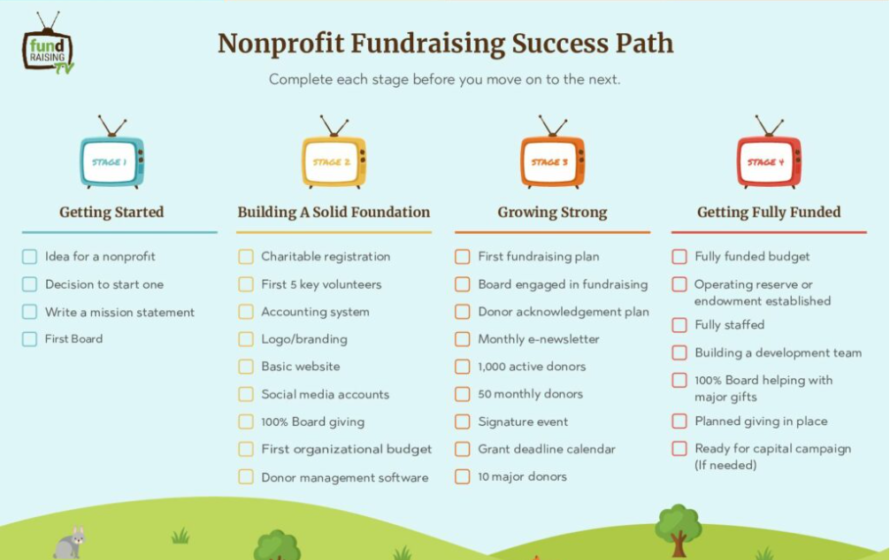 You’ve always been a helper, and now something has set your heart on fire and you think you might want to start a nonprofit.
You’ve always been a helper, and now something has set your heart on fire and you think you might want to start a nonprofit.
It’s a big step. And one to be taken VERY seriously.
Before you jump in, there are lots of things to consider and prepare for.
Once you start down this path, it will take a lot of work to get your fledgling nonprofit up and running.
You’ll have paperwork to do, volunteers to recruit, programs to develop, and money to raise. Plus about a hundred other things.
It’s not an easy journey. But it CAN be very rewarding.
So, let’s look at what it takes to start a nonprofit.
Most of this is specific to starting a nonprofit in the United States, but in general, it applies to starting a nonprofit in other countries, too.
Reality Check
You ready to work hard?
Starting a nonprofit isn’t easy.
According to Forbes, over half of all new nonprofits are destined to fail or stall within a few years due to leadership issues and the lack of a strategic plan — among other things.
That’s bad.
That means if you’re average, you have a 50% chance of making it.
So before you start a nonprofit, you need to ask yourself some hard questions and take stock of your time, your abilities, and your commitment to making your new venture successful.
- Is there TRULY a need to form a new nonprofit? Are there other nonprofits in your area that are serving the same purpose that you could join instead of starting your own?
- Do you have the time and skills required to effectively run a nonprofit organization?
- Do you have a good grasp on fundraising? How are you going to fund your new nonprofit?
- Are you prepared to recruit a responsible, well-rounded, and committed Board of Directors?
- Are you aware of all the federal and state laws and requirements for nonprofit organizations?
- Are you prepared to invest in systems, databases, and staff? (The NUMBER ONE reason nonprofits fail is leadership burnout and founders who try to do everything!)
Spend some time thinking through your answers to these questions. If you rush through them in your excitement to get started, you may be setting yourself up for a struggle.
Is There Truly a Need to Start a New Nonprofit?
 Step One in starting a nonprofit is research.
Step One in starting a nonprofit is research.
Check around to see if there’s another nonprofit already doing what you’re thinking of doing.
If so, can you join their organization?
There’s no reason to duplicate what someone else is already doing, and a lot of donors and funders don’t like it.
Donors don’t understand why there needs to be two homeless shelters in town or two golden retriever rescues.
If you don’t like the idea of joining forces with someone else, look to see what holes are being left unfilled.
Are there needs that other nonprofits aren’t addressing that your new nonprofit could meet?
It will be easier to market and raise funds for your new nonprofit if you can clearly define how your work is different from what others are doing.
Do you Have the Time and Skills Required to Effectively Run a Nonprofit Organization?
Running a nonprofit is A LOT of work.
It’s time consuming, it’s exhausting, and it’s not for the weary.
It takes much more than passion and a desire to help.
It takes real skills and lots of time.
A nonprofit leader needs to be able to manage staff and volunteers, multi-task, delegate, handle stress, and oversee all aspects of operations — including internal policies, social media, marketing, fundraising, networking, and still finding time for their lives outside of the organization.
A nonprofit organization should NOT be a part-time hobby.
If you’re serious about making a difference, you need to go all in!
Ready, Set, Jump!
 So, you think you’re ready.
So, you think you’re ready.
You’ve evaluated the time and commitment, and you’re prepared to do what it takes.
You’ve done your research, and you’re ready to address an unmet need.
It’s time to form your nonprofit!
You have a couple options at this point: you can do this yourself or hire someone to help.
Whichever direction you go, make sure that the attorney or accountant who helps you knows how to correctly fill out the paperwork.
Not sure who to ask for help? Start with Foundation Group. They set up more nonprofits in the U.S. than anyone else.
Taking the first steps to start a nonprofit is an exciting and scary time! So what to do now??
Here are the first 5 things you’ll need.
Mission Statement
Your mission statement tells the world why your nonprofit exists.
It defines the need you are wanting to fill and/or the services you want to provide.
Vague and dreamy words might sound nice rolling off the tongue, but your mission statement isn’t the place for those.
It should be short, succinct, and specific.
It should be written in plain language so that you could rattle it off on an elevator, and people would immediately understand the work you are doing.
Any member of your team should be able to recite your mission statement in a sentence or two.
Your mission statement should tell people:
- Who you serve
- How you serve (what do you provide)
- Why you serve (what is the need)
Your mission statement will help guide your decisions and determine your next steps as an organization for the coming years, so take the time to get this right.
Bylaws
Your bylaws are basically your nonprofit’s own rules for operation.
These are required in order for you to file for nonprofit status with the IRS and with your state.
Don’t let bylaws scare you, though.
You can do a google search for basic bylaws and work from there.
Be sure to customize them for your own situation. We’ve seen way too many nonprofits with cookie-cutter bylaws that weren’t very helpful.
Bylaws can be adjusted later by your Board as the nonprofit grows, and the rules for changing your bylaws should be included in your bylaws.
Bylaws typically address issues like:
- Purpose and activities of the nonprofit
- Responsibilities of the Board members
- Term limits for Board members
- When Board meetings will be held
- What constitutes a quorum on your Board
- What officers you have and how they are elected
- Standing committees of the Board
- What the fiscal year is
Choosing the Right Board
 Before you build your first Board, think about how many Board members you need and what skills will help get your new nonprofit off the ground.
Before you build your first Board, think about how many Board members you need and what skills will help get your new nonprofit off the ground.
Here in the U.S., the IRS requires at least 3 board members. Your state may require something more. We recommend 10-15 Board members so you have enough people to get things done.
When selecting your Board of Directors, be smart and think long-term.
Yes, it sounds great to gather a group of your friends or family and decide to start a nonprofit.
But will the Board members you pick be an asset to the organization?
Will they advocate, represent, and assist?
Do they have skills or connections that can help you further your cause?
The IRS has rules about family members serving on a nonprofit’s Board. As of June 2020, no more than two Board Members may be related, whether by blood or marriage.
In other words, you can’t have a Board that consists of you, your spouse, and a sibling or a parent.
It’s actually a bad idea to have a Board made up of only friends and family. Will they take their role seriously and help you make hard decisions? Or will they rubber stamp everything you want to do just because they love you?
It might be tough to get them to help raise money if you’re all related. Your circles of influence may be mostly the same.
Now, what about officers?
The IRS requires at least three Board members: a President, a Secretary, and a Treasurer.
And although they don’t forbid the Founder/Executive Director from taking any of these roles, it is highly frowned upon.
You might have to be the Founder and President initially, but you need to get good people in Board leadership roles as soon as you can. It gives you credibility when that person brings their reputation to the table.
If you are taking a paid position with your organization, it becomes very tricky. You really can’t be a paid Executive Director and a voting member of the Board at the same time. That’s like being an employer and an employee at the same time and can create conflicts of interest.
If you’re a paid Executive Director, you shouldn’t be a member of the Board. You should be a partner of the Board, working in tandem with its members to lead your nonprofit forward.
Registrations and Filings
Now that you’ve got your Board members, your bylaws, and your mission statement, it’s time to register your nonprofit!
You’ll want to file the appropriate paperwork with the IRS as well as any nonprofit filing requirements in your own state.
Do NOT overlook the state filings!
Many states require you to register your nonprofit PLUS register for a charitable solicitation license that permits you to raise funds in your state.
These are two completely different things, but both are mandatory.
Also, check with your local city or county to see if additional registrations are needed.
Insurance

Depending on your situation, you may need a variety of different kinds of insurance to safely operate your nonprofit.
Here’s where a knowledgeable Board member can be very handy!
If you have a facility, you will want to have insurance to cover basic liability, including any volunteer or visitor injuries.
If you have an animal rescue, you’ll want insurance to cover any bites or injuries.
Have a company vehicle? Is that insured for volunteers to drive it, or can it only be paid staff who drive it?
If you plan to host fundraising events, most venues will require insurance.
What about Directors and Officers liability insurance (commonly called D&O) or Errors and Omissions (commonly called E&O) liability insurance? These protect your nonprofit against mistakes, negligence, and more.
Find an insurance company in your area that works with other nonprofits, and ask them to help you evaluate your needs.
Time to Swim
You’ve jumped in, and now it’s time to swim!
Once your nonprofit is all set up, there are several things you should do in the first 90 days or so to create a strong foundation for success.
Remain Flexible
 In the early days after you start a nonprofit, it’s important to be open-minded and flexible.
In the early days after you start a nonprofit, it’s important to be open-minded and flexible.
Remember…you’re learning every day.
You’ll find some things that work and other things that don’t.
You might find you feel more strongly about something or less strongly about something else over the next few months.
As long as you’re staying true to your mission, don’t be afraid to acknowledge that your nonprofit is a work in progress.
Being open to changing courses or looking at things from a different perspective will keep your new nonprofit strong, relevant, and well-liked by your volunteers and supporters.
Stay focused on your mission and those your nonprofit serves.
You have a lot of good work to do, and it’s time to get busy changing lives!
Additional Resources
Success Path. Grab a copy of our Nonprofit Fundraising Success Path so you can see what you need to focus on as you start and grow your nonprofit. https://getfullyfunded.com/success-path/

Beginner’s Guide to Fundraising. Here’s everything you need to know to get your nonprofit fundraising journey up and running. https://getfullyfunded.com/fundraising-for-beginners/






Leave A Comment